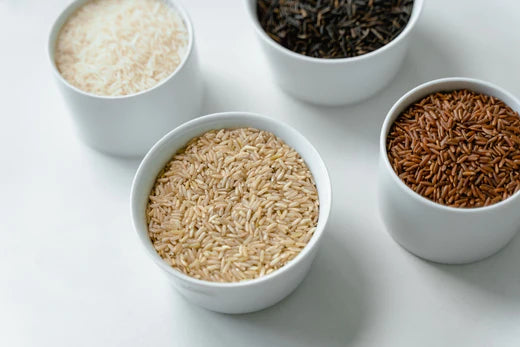A staple found in all homes; rice is known for many variations across regions. At Conscious Food, this household staple comes in many colours and nutritious benefits.
Let’s take a closer look at understanding how each rice is different and how they can be incorporated in our daily routines.
TYPES OF RICE
When combined with other foods such as vegetables, white rice can help prevent blood sugar spikes. It is a hypoallergenic food that is also beneficial to people who are allergic to gluten or have celiac disease because it contains a high amount of carbohydrates that absorb quickly.
It belongs to type 1121 and its slender grains lend an air of grandeur to all dishes. Comes from the fertile plains of Punjab, nourished by the waters of the holy rivers. While white rice is the most popular, red, brown, and black rice are rising to popularity as healthier substitutes.

2. Brown Rice
Brown rice retains the bran and germ layer in the kernel, thus preserving essential nutrients These two layers increase the fibre, vitamin, and mineral content in the rice, making it a healthier substitute to white rice. It also has a lower glycemic index that controls insulin spikes and contributes to better diabetes control
Brown Rice is unpolished and unrefined. Owing to a thicker coating, it takes longer to cook brown rice. The ratio for the water can be around 2–3 cups per 1 cup of rice. Further, soaking the brown rice for about an hour before cooking, reduces the cooking time to 35–40 minutes.
At Conscious Food, you can choose between small-grained brown rice and long-grained brown rice.
3. Red rice:
With a higher mineral content, red rice promotes bone health. Further, red rice is also high in soluble and insoluble fibres that aid digestion and promotes a healthy metabolism
The vibrant colour, given by its primary nutrient anthocyanin, makes this rice stand apart. It is another healthy alternative to white rice and can be used in many ways to enjoy its nutritious benefits.
Red rice also takes longer to cook than white rice and can be pre-soaked to reduce the cooking time. A ratio of 1 part rice to 2 parts water and pressure cooking the rice leads to a wholesome plate of flavourful rice to accompany your favourite meals.
Conscious Food’s red rice is small, unpolished, and unhulled, and lovingly and sustainably sourced for your table.

4. Black rice:
Black rice is rich in proteins, iron, and antioxidants. Furthermore, it is also gluten-free and a wholesome substitute for white rice. Owing to its higher nutrition content and thicker texture, it is also stickier when cooked. Thus, it makes a great component of sushi and sticky rice pudding.
A unique dish known for its medicinal and flavourful blends. It is also known as Purple rice, Emperor’s rice, Forbidden rice, or more locally as Chak-hao. Its extra nutty flavour adds a delicious taste to every dish it is accompanied with.
For its preparation, prewash black rice 2–3 times in cold water. Take a proportion of one cup rice and two and a half cups of water and boil it gently.
At Conscious Food, the long grains of black rice are locally and sustainably sourced. They are unprocessed to ensure all nutrients are retained and can make way for nourishing meals
CONCLUSION
Red, brown, and black rice are becoming more and more popular as healthier alternatives to white rice, which is the most often consumed type. At Conscious Food, we examine more closely at how each type of rice differs from the others and how we can use them in our daily lives. Black rice is a distinctive meal that was once only served to Chinese aristocracy and is renowned for its flavorful and medicinal combinations. It is stickier when cooked because of its higher nutritional value and thicker texture. It works well as a component of sticky rice pudding and sushi.
-






